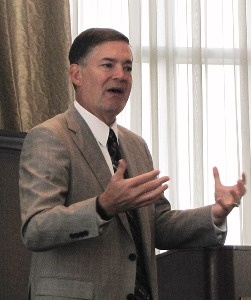Curtis Carver, CIO at U. of Alabama at Birmingham wasn't looking for a new job, but as he learned more he got excited about the opportunity.
Curtis Carver, the latest subject in our “How I Landed my New CIO Job” series, became Vice President and CIO at The University of Alabama at Birmingham in June 2015.
Were you actively looking for a new CIO role?
Curtis Carver: Definitely not. I was in my sixth year as vice chancellor and CIO at the University System of Georgia, and I was four years from retirement. Career-wise everything was going great for me there. We had even won some prestigious awards for our accomplishments in IT across the system, which includes 30 higher education institutions, such as the University of Georgia and Georgia Tech, and the Georgia Public Library System. My wife and I were extremely happy living in Georgia, so the easiest path for me would have been to continue in that very satisfying role in a great university system.
How did you hear about this CIO opportunity?
An executive recruiter contacted me about the CIO role at The University of Alabama at Birmingham, or UAB, in late 2014. At first I said, “No, thank you. Not interested. We are happy where we are.” But over time, after a few conversations with him about the job, he convinced me to at least participate in the process.
What did you hear that caught your interest?
Moving from no to maybe was a gradual process. The recruiter did a good job because I had to have been his hardest sell. He highlighted to me how this was a unique opportunity to build a world-class IT organization from the ground up and return to a vibrant campus. Also, the city of Birmingham is experiencing a renaissance and seems to be poised for an innovation and technology revitalization realized through partnership between its research university and the city.
Eventually I realized that this was a unique and special opportunity, and that maybe I wasn’t ready to coast into retirement. I got very excited to actually build a top-notch IT organization essentially from scratch.
What I learned after this process is that, even when you think you have your mind made up, it’s still good to keep an open mind.
What attracted UAB to your background?
I had a history of turning around troubled IT organizations. UAB had had interim IT leadership for four or five years, which was not ideal. This a world-class research university and they felt they absolutely had to hire a permanent CIO who could build a world-class IT capability to match. It was important to the institution’s competitive advantage. They wanted someone who had turned around an IT organization, could get on the ground and start getting things done.
How did you prepare for your interviews?
I spent time learning more and more about the university, and just as important, the people I was to interview with. I made a list and wrote notes next to their names, things like their military service, involvement with charities, career highlights—any personal connections to spark conversations and give them the ability to talk about themselves. As they spoke about themselves, I learned about the university, the community, and about how I might fit into it.
The standard interview questions are easy, but how well you do all comes down to the preparation. Not so you are reading from a script, but so that you can relax and listen more carefully and respond intelligently.
Universities have a lot of ceremonies and rituals, as we all know. At UAB one of the colors is green, so for every face-to-face interview I had some green in my tie. That kind of nuanced thinking makes a difference.
What was your interview strategy?
In my case, I wanted to use each interview to learn more and more about the organization to make sure we had a good fit. I was interviewing them as much as they were interviewing me. There was no pressure for me to move. I knew that if this were to move ahead, this would be my last job. From my perspective, the fit had to be perfect as this would be a commitment for the next decade.
What was most memorable to you about the interview process?
 Things moved slowly and developed very gradually, which was a positive for everyone. In the end, there were five rounds of face-to-face interviews. The final meeting was with the CEO of the UAB Health System. I had already met everyone else on my previous visits, but I volunteered to drive down from Athens, Georgia, about a three-hour drive, to meet with him in person. Later he told me that the fact that I had driven down rather than hold a video conference led him to believe I was the best candidate. It signaled to him that I knew how important our conversation was.
Things moved slowly and developed very gradually, which was a positive for everyone. In the end, there were five rounds of face-to-face interviews. The final meeting was with the CEO of the UAB Health System. I had already met everyone else on my previous visits, but I volunteered to drive down from Athens, Georgia, about a three-hour drive, to meet with him in person. Later he told me that the fact that I had driven down rather than hold a video conference led him to believe I was the best candidate. It signaled to him that I knew how important our conversation was.
I think that HR executives and hiring committees should take their time during the interview process, and build relationships. For a role like this you can’t employ a factory model for evaluating candidates. The largest part of the job at this level is leadership, and that can only be ascertained through repeated personal engagements.
As a result of the thorough interview process, the offer letter I received was not a typical offer letter. It contained the strategic imperatives they wanted me to work on, in priority order. We had discussed them already, in depth during the interview process, so they did not come as a surprise and were perfectly aligned with the goals of the university. The list was quite nuanced, and formed the basis for my strategic plan.
How much longer were you at the University System of Georgia?
I accepted the UAB job in March but didn’t start until June. I think it is poor form when a CIO gives two weeks or even one month’s month notice. It is better to take the time to think and plan strategically about your first day, first week, first 30 and first 100 days before you start the job. It is better to strategically commit your political goodwill in your previous job for the benefit of the university system and its constituents.
Part of a leadership role is developing sustainable organizations with succession planning, and while the University System of Georgia did an external search, I felt good that interim leadership was prepared to keep the organization running.
Also, in the Atlanta area, most of the CIOs know each other. We get together. We break bread together. There are relationships built, and you burn those relationships if you give short notice. Be gracious with your old employer because you may end up working for them again.
Who do you report to?
The president of the university.
What you have been able to accomplish so far?
I recently calculated that I had 800 meetings in my first 100 days. I also held three IT Town Halls.
But more important, I made it a priority for the IT department to move quickly on the requests I was hearing. I didn’t wait until all the ideas and requests had been collected and analyzed.
On my first day, we launched SPARK, a new crowdsourcing site where people across the entire university can make suggestions about IT. It took about three months to develop the site, which re-emphasizes the advantages of being strategic with your transition.
In IT we also use a collaboration software called TeamBrain, which allows you to quickly share what comes out of meetings. So there I was at these 800 meetings last summer typing in notes on what was being said, and we were acting on many of those requests in real time. The crowdsourcing site helped immensely with the prioritization and transparency.
What has the response been?
Very positive. People think we’ve accomplished more in five months than they expected to see after two years.
There was a lot of pent-up demand, including some small projects that were easy to do.
I am a strong believer in moving at "the speed of trust." If you act on your customers’ needs quickly, you continue to extend the honeymoon period. Those people who had been critics of IT before now see you are delivering enhancements so quickly that they are willing to suspend their skepticism, give you their trust and follow your lead. It is key to moving from a utility to a strategic partner.
Here is an example: The advancement office solicits many donations from the telephone calls they make. For some reason, their phone calls showed up on caller I.D. as anonymous, which caused many people to ignore or block their calls. This had been in place for six years, and they wanted it changed. Within 15 minutes of finding out about it, we were able to make the change so that people would see that it was the University that called. As a result, their callback rates skyrocketed, and they were able to increase external funding for student scholarships.
What other improvements are you proud of?
From the beginning a big question for me was “What can we do to fix research computing?” Researchers were frustrated by computer performance, network speed, and the lack of available storage space. Genomics research, for example, creates enormous amounts of data.
We tried to tackle all of these issues, and we have made great progress. Through a grant initiated by my predecessor, we have been able to establish a brand new, separate research network that has quadrupled the speed of our research networks. The president committed innovation funds to quadruple the speed of the research computers.
We received another grant from the State of Alabama for which I was the principal investigator, and this grant quadrupled our research storage. In addition, we recently signed an agreement with Box which provides unlimited storage to our researchers. All of this occurred within the first six months of my tenure.
What about changes to the IT organizational structure?
In order to achieve my goal of a world-class IT function for this top university, our core services must be delivered flawlessly. I myself cannot focus on the highly strategic, game-changing opportunities until that happens.
So I established a new leadership layer directly below me made up of a deputy CIO, a CTO, and a CISO, positions we filled after national searches for the best candidates we could find.
As we mature each core service, it will be turned over to one of these leaders. We will start with core enterprise services that must run flawlessly – that is the responsibility of the CTO. One of my next areas of focus is business process optimization, which will one day get turned over to the deputy CIO, whose responsibility will be to keep that function running flawlessly. Then I can move on to game-changing strategic projects that will increase UAB’s ability to recruit, retain, and graduate students and also increase our competitiveness for research funding.
A percentage of the compensation for the new deputy CIO, CTO and CISO is performance-based, which is rare in higher education. I wanted these individuals not only accountable for, but also hungry for that flawless performance.
What does digital transformation mean at UAB?
For UAB IT, digital transformation is a core service that must be delivered flawlessly.
Through technology, we empower great educators and researchers to inspire the next generation of leaders and ideas. This is the very essence of a world-class university.
How do you know when your IT organization is succeeding?
Our success is dependent upon engagement with the community we serve. This comes when the community believes that the IT organization is making their lives better—which comes from hundreds and thousands of interactions per month—and when they’re saying that we are their competitive advantage.
Ultimately, it is when the people with discretionary budget choose you over other options they have. A vote gets cast when they decide who to engage as their IT provider.
When our employees, who can choose other jobs at other employers, choose to work here, that is another strong indication we are succeeding. Being asked to sit at the table on more and more projects and being asked by customers to help them solve more and more problems demonstrates that IT has transitioned from a commodity provider to a true strategic partner
About Curtis A. Carver Jr., Ph.D.
 Dr. Carver was named vice president for Information Technology and chief information officer at the University of Alabama at Birmingham in June 2015. In this role he leads a team of dedicated professionals who support UAB’s mission by providing world-class IT solutions with a focus on innovation, agility, and cost efficiency.
Dr. Carver was named vice president for Information Technology and chief information officer at the University of Alabama at Birmingham in June 2015. In this role he leads a team of dedicated professionals who support UAB’s mission by providing world-class IT solutions with a focus on innovation, agility, and cost efficiency.
Carver came to UAB from his position as vice chancellor and chief information officer for the Board of Regents of the University System of Georgia, having previously held key leadership positions at the U.S. Military Academy at West Point. He earned a bachelor’s degree in computer science from the U.S. Military Academy at West Point and his master’s degree and doctorate in computer science from Texas A&M University.
Follow Curt on twitter: @carverc



Add a Comment